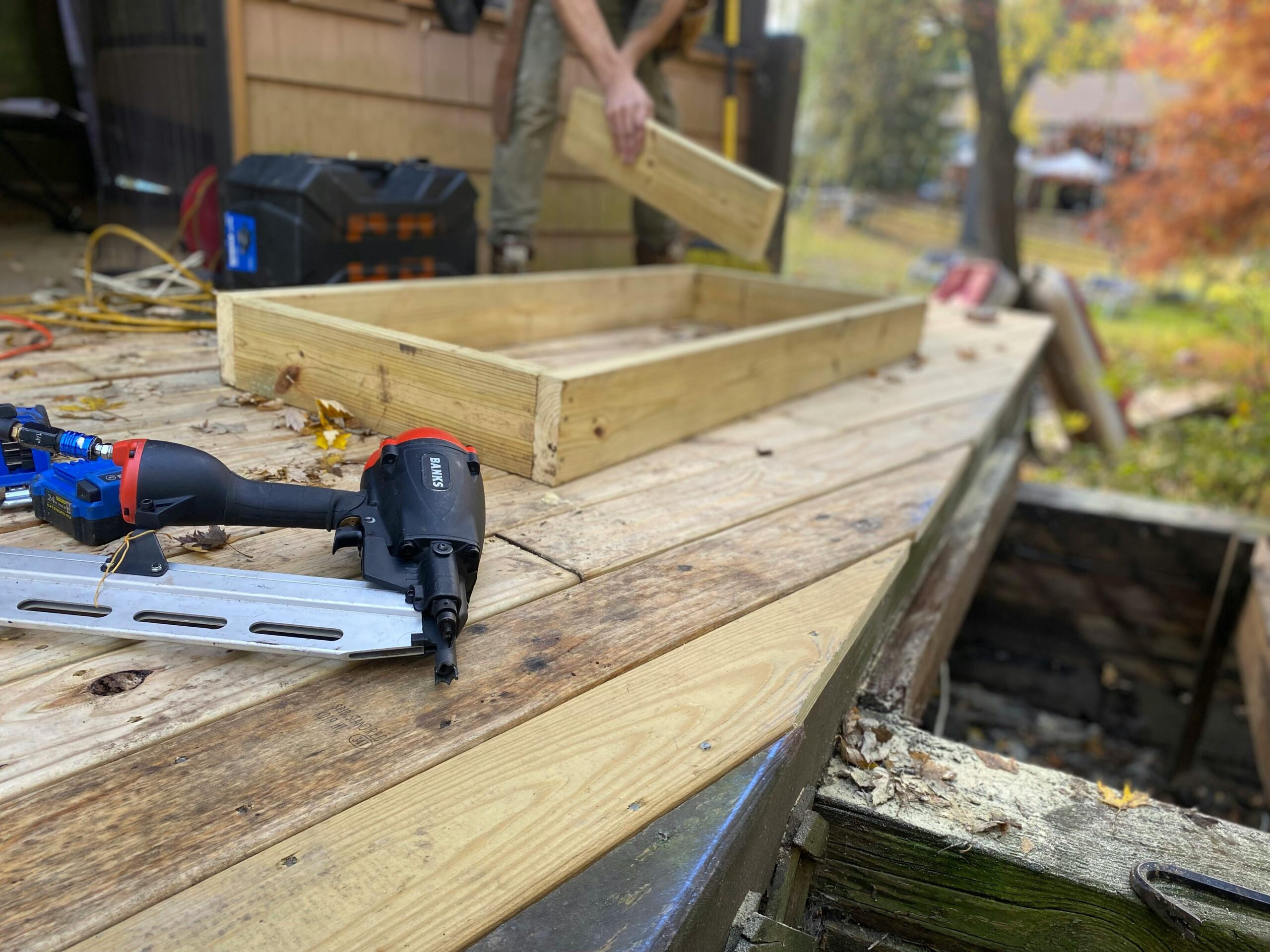A nail gun is a powerful tool that can significantly increase productivity and efficiency in various woodworking, construction, and home improvement projects. However, like any tool, it can sometimes malfunction or require maintenance. Understanding how to troubleshoot and fix common issues with a nail gun can save you time and money, and ensure that your projects continue smoothly. This guide will walk you through the most common nail gun problems and how to fix them.
Common Nail Gun Problems and Solutions
1. Nail Gun Jams
Symptoms: Nails are not firing, or nails are getting stuck in the magazine or barrel.
Solution:
- Disconnect the Power Source: For safety, always disconnect the nail gun from its power source, whether it’s pneumatic, electric, or battery-powered.
- Open the Magazine: Depending on your nail gun model, release the latch to open the magazine.
- Remove Jammed Nails: Carefully remove the jammed nails using pliers or by hand.
- Clear the Barrel: Check the barrel for any remaining debris or nails. Use a thin tool or compressed air to clear it out.
- Reassemble and Test: Reassemble the nail gun and test it to ensure it’s working correctly.
2. Nail Gun Not Firing
Symptoms: The nail gun clicks, but no nails are driven out.
Solution:
- Check the Air Supply (Pneumatic Nail Guns): Ensure that the compressor is working and that the air hose is properly connected.
- Inspect the Battery (Cordless Nail Guns): Make sure the battery is charged and properly seated in the nail gun.
- Examine the Trigger: Check if the trigger mechanism is obstructed or damaged. Clean and lubricate if necessary.
- Inspect the Safety Mechanism: Ensure that the safety tip is fully depressed when attempting to fire. Sometimes dirt or debris can obstruct it.
- Check the Magazine: Ensure that nails are loaded correctly and that the magazine is not damaged or misaligned.
3. Air Leaks in Pneumatic Nail Guns
Symptoms: Hissing sound from the tool or loss of power.
Solution:
- Identify the Leak: Spray soapy water around the connections and look for bubbles to identify the source of the leak.
- Tighten Connections: Tighten any loose fittings or connections.
- Replace O-rings: Worn or damaged O-rings can cause leaks. Replace them as needed.
- Check the Hose: Inspect the air hose for cracks or holes and replace it if necessary.
4. Double Firing
Symptoms: The nail gun fires two nails instead of one.
Solution:
- Adjust the Depth Setting: Some nail guns have a depth setting that can be adjusted. Ensure it’s set correctly.
- Check the Trigger: Ensure that the trigger is not getting stuck in the depressed position.
- Lubricate the Nail Gun: Apply appropriate lubricant to the moving parts of the nail gun to ensure smooth operation.
- Inspect the Safety Mechanism: Ensure that the safety mechanism is functioning properly and is not causing the double firing.
5. Nails Not Driving Flush
Symptoms: Nails are not driven fully into the material, protruding from the surface.
Solution:
- Adjust the Depth Control: Most nail guns have a depth control setting. Adjust it to ensure nails are driven to the desired depth.
- Check the Air Pressure (Pneumatic Nail Guns): Ensure the air pressure is set to the recommended level for your nail gun and the material you’re working with.
- Use the Correct Nails: Ensure you are using the right type and size of nails for your nail gun and the material.
- Inspect the Driver Blade: A worn or damaged driver blade can prevent nails from being driven fully. Replace if necessary.
Maintenance Tips for Nail Guns
Regular maintenance can prevent many of the issues mentioned above and extend the lifespan of your nail gun.
1. Clean Your Nail Gun Regularly
- Remove Debris: Clean the nail gun after each use to remove dust, debris, and residue.
- Lubricate Moving Parts: Apply appropriate lubricant to the moving parts, especially the trigger mechanism and magazine.
2. Check and Replace Worn Parts
- Inspect O-rings and Seals: Regularly check O-rings and seals for wear and replace them as needed.
- Examine the Driver Blade: Ensure the driver blade is sharp and not damaged.
3. Store Properly
- Dry Storage: Store your nail gun in a dry, cool place to prevent rust and damage.
- Disconnect Power Source: Always disconnect the power source when not in use.
4. Follow Manufacturer’s Instructions
- Read the Manual: Always refer to the manufacturer’s manual for specific maintenance tips and troubleshooting advice.
- Use Recommended Accessories: Use only the nails, lubricants, and parts recommended by the manufacturer.
What are the common types of nail guns?
The common types of nail guns include framing nailers, finish nailers, brad nailers, roofing nailers, and flooring nailers. Each type is designed for specific tasks such as heavy-duty framing, detailed trim work, or installing flooring.
Why is my nail gun not firing?
Your nail gun may not be firing due to several reasons, including a lack of power, an empty magazine, a jammed nail, or an engaged safety mechanism. Check the power source, ensure the magazine is loaded, clear any jams, and make sure the safety is properly engaged.
How do I clear a jammed nail gun?
To clear a jammed nail gun, first disconnect it from its power source. Open the magazine and remove any jammed nails with pliers or by hand. Clear the barrel of any remaining debris and reassemble the nail gun before testing it.
What maintenance does a nail gun require?
Maintenance for a nail gun includes regular cleaning, lubricating moving parts, checking and replacing worn O-rings, and inspecting the driver blade for wear. Proper storage in a dry, cool place and following the manufacturer’s guidelines are also important.
Why is my pneumatic nail gun leaking air?
A pneumatic nail gun may leak air due to loose fittings, worn O-rings, or a damaged air hose. Tighten connections, replace worn O-rings, and inspect the air hose for cracks or holes to fix the leak.
How do I adjust the depth setting on a nail gun?
To adjust the depth setting on a nail gun, locate the depth adjustment mechanism, which is usually a dial or knob near the trigger. Rotate the dial or knob to set the desired depth, then test on a scrap piece of wood to ensure the nails are driven to the correct depth.
Can I use different types of nails in my nail gun?
Different nail guns require specific types and sizes of nails. Always refer to the manufacturer’s guidelines to ensure compatibility. Using the wrong nails can cause jams, misfires, and damage to the nail gun.
Why is my nail gun double-firing?
Double-firing can be caused by incorrect trigger settings, a sticky trigger mechanism, or an issue with the safety mechanism. Adjust the trigger settings, lubricate the trigger mechanism, and ensure the safety mechanism is functioning properly to prevent double-firing.
How often should I lubricate my nail gun?
Lubricate your nail gun regularly, typically before each use or after every few hours of continuous operation. Use the lubricant recommended by the manufacturer to ensure smooth operation and prevent wear on moving parts.
What should I do if my nail gun is driving nails too deep?
If your nail gun is driving nails too deep, adjust the depth setting to a shallower depth. Ensure the air pressure (for pneumatic nailers) is within the recommended range, and verify that you are using the correct nail length for your application.
Why is my battery-powered nail gun not holding a charge?
A battery-powered nail gun may not hold a charge due to a faulty battery, charger issues, or internal problems with the nail gun. Check the battery and charger, and if necessary, replace the battery or consult the manufacturer for further assistance.
Can I repair a damaged air hose for my pneumatic nail gun?
Yes, you can repair a damaged air hose using a hose repair kit that includes connectors and clamps. However, for safety and reliability, it may be best to replace a severely damaged hose with a new one.
Why is my nail gun not sinking nails fully into the wood?
If your nail gun is not sinking nails fully into the wood, adjust the depth setting, increase the air pressure (for pneumatic nailers), or ensure the battery is fully charged (for battery-powered nailers). Check for any obstructions or worn parts that may affect performance.
What safety precautions should I take when using a nail gun?
Safety precautions include wearing protective gear (safety glasses, ear protection), ensuring the work area is clear, keeping hands away from the nail path, using the safety mechanism properly, and disconnecting the power source when performing maintenance.
How do I prevent my nail gun from jamming?
Prevent jams by using the correct nails, keeping the nail gun clean, lubricating moving parts, and properly loading the magazine. Regularly inspect the nail gun for wear and replace any damaged components.
Can I use a nail gun for upholstery work?
Brad nailers and staple guns are commonly used for upholstery work due to their precision and ability to handle small fasteners. Ensure you use the appropriate type and size of nails or staples for your upholstery project.
Why is my nail gun misfiring?
Misfiring can be caused by improper nail loading, a jammed nail, low air pressure (for pneumatic nailers), or battery issues (for battery-powered nailers). Check the magazine, clear any jams, ensure proper air pressure, and verify the battery charge.
How do I know if my nail gun’s O-rings need replacing?
Signs that O-rings need replacing include air leaks, reduced performance, and difficulty in firing nails. Regularly inspect O-rings for wear, cracks, or damage, and replace them as part of routine maintenance.
What type of lubricant should I use for my nail gun?
Use a lubricant specifically designed for pneumatic tools or as recommended by the nail gun manufacturer. Avoid using general-purpose oils that may contain additives that can damage the nail gun’s components.
Can a nail gun be used for concrete or masonry work?
Specialized nail guns, such as powder-actuated tools (PATs), are designed for concrete or masonry work. Standard nail guns are not suitable for these materials. Always use the appropriate tool and fasteners for the job.
How do I fix a nail gun that won’t retract the driver blade?
If the driver blade won’t retract, check for jams, clean and lubricate the mechanism, and inspect for worn or damaged parts. If the issue persists, the driver blade or internal components may need replacing.
Why is my electric nail gun sparking?
Sparking in an electric nail gun can indicate electrical issues, such as worn brushes, a faulty trigger switch, or internal wiring problems. Discontinue use immediately and have the nail gun inspected and repaired by a qualified technician.
What should I do if my nail gun is making unusual noises?
Unusual noises may indicate internal issues or wear. Disconnect the power source, inspect the nail gun for visible problems, and perform routine maintenance. If the noise persists, consult the manufacturer or a professional repair service.
How do I store my nail gun when not in use?
Store your nail gun in a cool, dry place, preferably in its original case or a protective bag. Disconnect the power source, clean the tool, and perform any necessary maintenance before storage.
Can I use my nail gun outdoors?
Yes, you can use a nail gun outdoors, but ensure the tool is suitable for the conditions. Avoid using pneumatic nailers in wet environments due to potential moisture damage. Always follow safety guidelines and manufacturer recommendations for outdoor use.
Why is my nail gun overheating?
Overheating can result from prolonged use, insufficient lubrication, or internal issues. Allow the nail gun to cool down, lubricate moving parts, and inspect for any obstructions or damage. If the problem persists, have the tool checked by a professional.
How do I prevent rust on my nail gun?
Prevent rust by storing the nail gun in a dry place, keeping it clean, and applying a light coat of oil to metal parts. Regular maintenance and proper storage practices can help protect against rust and corrosion.
What are the signs of a worn driver blade in a nail gun?
Signs of a worn driver blade include nails not being driven fully, irregular nail depth, and frequent jams. Inspect the driver blade regularly and replace it if it shows signs of wear or damage.
Can I use a nail gun with different power sources?
Some nail guns are designed to be versatile with multiple power sources, such as battery and pneumatic options. Always refer to the manufacturer’s guidelines to ensure compatibility and safe operation.
What should I do if my nail gun’s magazine is damaged?
If the magazine is damaged, replace it with a new one compatible with your nail gun model. Using a damaged magazine can cause misfires, jams, and safety hazards. Consult the manufacturer for replacement parts and installation instructions.
Conclusion
Fixing a nail gun involves understanding common problems such as jams, misfires, and air leaks, and knowing how to address them. Regular maintenance, such as cleaning, lubrication, and checking for worn parts, can prevent many issues and ensure the longevity of your tool.
By following the steps outlined in this guide, you can troubleshoot and fix most nail gun problems, keeping your projects on track and your tool in top condition. Always prioritize safety by disconnecting the power source before performing any maintenance or repairs.



